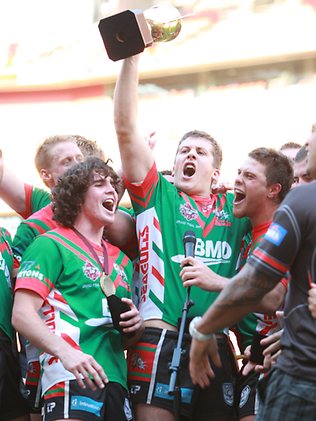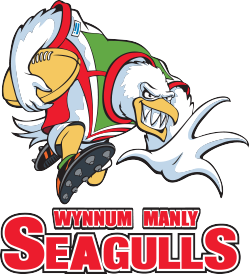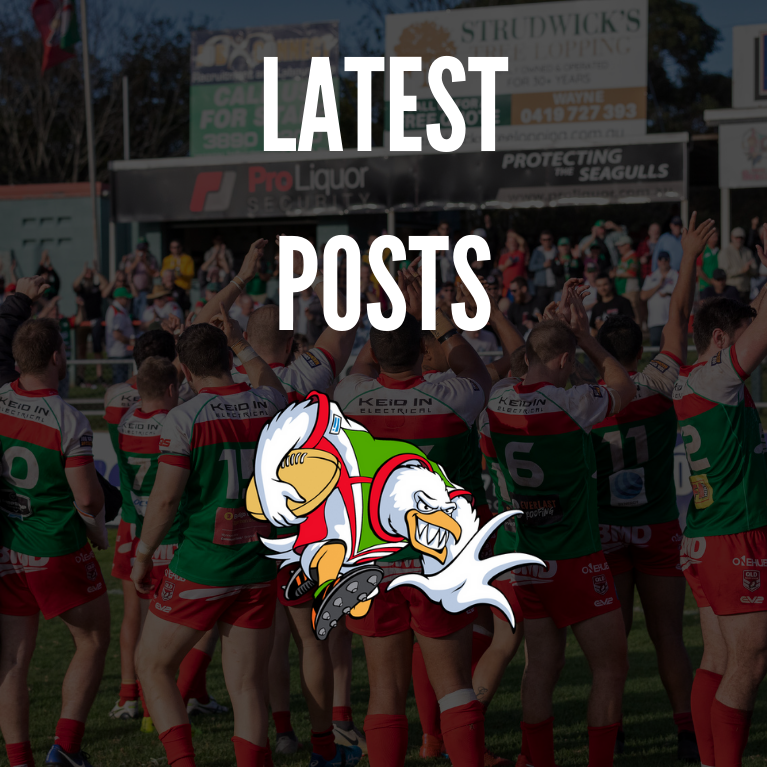THROUGH THE YEARS…

represented the Queensland side in 1925
Wynnum Manly were admitted to the Brisbane District Rugby League Competition in 1951 joining Valleys, Norths, Souths, Easts, Wests and Past Brothers. However, this wasn’t the first time a rugby league team from Wynnum had competed in the Brisbane Competition. Way back in 1914 the original Wynnum District Football Team was formed to complete in the Queensland Rugby League Competition.
In that year. Ironically, this team came into existence because of the advent of Electorate Football. Electorate Football was the first attempt to set up a regular club competition in Brisbane based along district lines. The teams were actually drawn from Wards, hence the name Electorate football. This team was bolstered by the inclusion of Bundaberg brothers Mick and Henry Bowleski, 2 of the early stars of rugby league in Queensland. Mick was one of 4 Queenslanders to tour England with the 1908-09 Kangaroos and the first Queenslander to play professional rugby league (in England with the Leigh club). Henry made his one and only test appearance that year against the touring British Team giving this short lived club the distinction of having an international representative.
Although they started the season strongly, the club faded badly in the second half of the year to miss out on a place in the semi finals. Sadly, Wynnum did not reappear in the competition the following year. A team from Bulimba appeared in their place and some of the players who turned out for Wynnum in 1914 played for them. No doubt the First World War which started at the end of the 1914 season also took its toll on player numbers.
On the 2nd of February 1931 the short lived Wynnum District Rugby Union Club disbanded and its members hastily formed a new club (the Wynnum District Rugby League Club) and affiliated with the Brisbane Rugby League. Playing in an all black strip, the club was based in the heart of the district at Kitchener Park and included players such as Glen (Paddy) Crouch and Bill Patten.
Glen Crouch was a top centre who had previously played for Cooparoo. He toured New Zealand with the 1925 Queensland side, rated by many as the finest team to ever visit the Shaky Isles. The Crouch family has a long association with sport in the Wynnum district with Paddy’s brother Bob also playing in the team and his son, Glen Junior, playing for Wynnum-Manly in the 1950s.
Bill Patten, originally from Ipswich was a top winger who was a regular in Queensland sides throughout the 1920s and played two test matches for Australia. In those days the Brisbane competition was club oriented and featured teams such as Carltons, Grammers and University. The club-oriented competition had always struggled to gain support from the public and the BRL had for some time been attempting to establish district teams that represented the various geographic parts of Brisbane.
When District Football was finally established in 1933, this short-lived incarnation of Wynnum merged with Cooparoo to form Eastern Suburbs. Some of Wynnum’s players and committee members joined the merged entity. Others continued playing the Wynnum District Competition. Teams in the old Wynnum District League included Manly, Waterloo, Dunwich, Fisherman, Hemmant and Wynnum Central. These teams formed a Wynnum representative side that competed for the Geraghty Cup. Their opponents in these contests included Redcliffe, Beaudesert, Logan & Albert Shire and South Coast. Indeed it was Wynnum’s dominance of the Geraghty Cup in 1950 that paved the way for their introduction into the Brisbane Competition as Wynnum-Manly in 1951.
Wynnum-Manly (the 1951 vintage) trained and played their home games at Kitchener Park. Not being an enclosed ground, club officials were forced to rope-off the area immediately around the playing field with hessian screens so they could charge admission. Facilities for players and patrons were minimal so spectators typically stood along the sidelines to watch play.
Though it is for the most part long forgotten, Wynnum-Manly’s original colours were actually Green and Gold. In 1957 the Australian Rugby League forced the colours to be changed as they clashed with those of the national team. It was then that Wynnum-Manly adopted the now familiar Green and Red.

Charlie Roff, a junior product of the Waterloo club in the old Wynnum district competition who had played for Western Suburbs before Wynnum-Manly were admitted to the BRL had the honour of captaining Wynnum-Manly in their first game. He would later become a long serving committee member with the club and an Australian Selector.
Roff family had a long association with rugby league in the Wynnum district as Charlie’s father Russell had been a member of the 1914 Wynnum team and served on various committees of the Wynnum-Manly club. Abbie Thurlow was the initial First Grade Coach.
John Cloherty, who played for Wynnum in the early 30s was the clubs first president, a position he held until his retirement in 1966. Wynnum-Manly played their first A grade game against Eastern Suburbs at the Brisbane Cricket Ground (the Gabba) on 7th of April 1951. Although Wynnum-Manly enjoyed immediate success in the lower grades by winning the under 20s title in 1952, the early years would be a struggle for the club. Indeed, during these early days Wynnum-Manly suffered their share of heavy defeats, the most significant of which was an 89-11 mauling at the hands of Valleys at Kitchener Park in 1953 (the great Norm Pope kicked 19 goals for the Diehards).
A lot of Wynnum-Manly’s players in these early days were professional fishermen. Match payments and bonuses were largely unheard of in those days so when the fishing was good the priority of many of the players were the boats and Wynnum-Manly would struggle to field a competitive team.
Legend has it that in those early days a bus would drive from pub to pub within the district on a Saturday afternoon to pick up players. Once a sufficient number of players had been procured, teams would be organized, literally on the bus, on the way to the game. If numbers were short it was not uncommon for players to ‘double up’ and play two or even three games in a day.
From the mid 1950s onward Wynnum-Manly began to make their presence felt. A batch of top juniors where emerging in the district. This nucleus of players which included Bobby Cook and Marshall Barnfield won the under 16s, 17s and 18s between 1953 and 1955.
In 1956 Wynnum-Manly signed Keith ‘Bomber’ Brown, a top centre from Eastern Suburbs as Captain-Coach and under his leadership, made the semi-finals for the first time that year. Wynnum-Manly became semi-final regulars during this era, also featuring in the play-offs in both 1958 and 1959. Some of the more prominent players to appear for Wynnum-Manly in this era included the Greenhill brothers (Bob, Les, Roy and Harry) and Steele Davis.
1957 provided a couple of firsts; Wynnum-Manly made their first Senior Grand Final (Reserve grade, Wynnum finished last in 1st Grade!). The reserve grade team, surged through the second half of the season with 11 straight wins to make the grand final. On the day they were defeated 20-8 by Western Suburbs. Hooker Alan Hornery became the clubs first Queensland representative (he had previously represented Queensland while playing for both Souths and Wests).
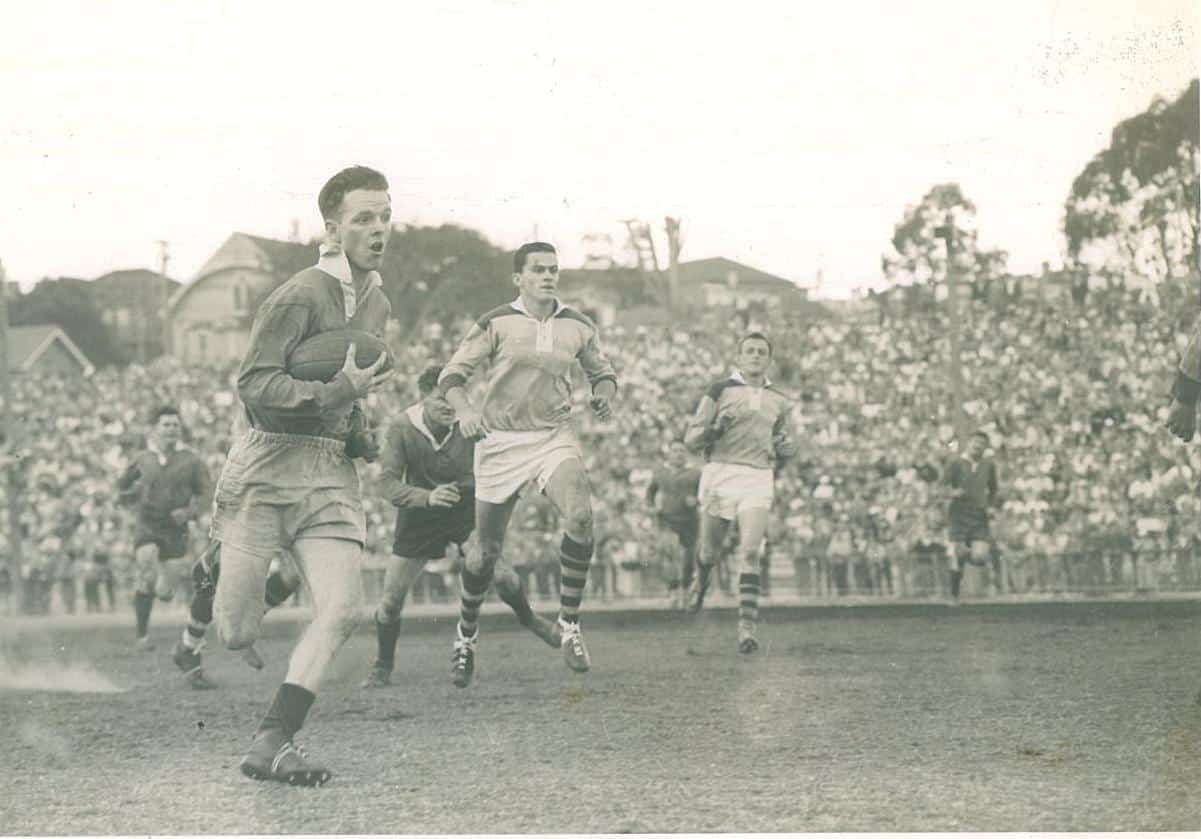
Wynnum-Manly won their first Trophy (the Presidents Cup) in 1959, defeating Northern Suburbs (Captain-Coached by the legendary Clive Churchill) 12-10 at Lang Park. The Presidents Cup was an annually contested Trophy between the top two teams at the end of the first round of fixtures (In those days 3 rounds of fixtures were played during the regular season). This was the year that the exciting winger, Lionel Morgan joined the club. He became Wynnum’s first international in 1960 and the first Wynnum-Manly player to tour with an Australian side (1960 World Cup Squad). 1959 saw Wynnum-Manly make it all the way to the Preliminary Final where Norths avenged their President Cup defeat, winning 12-3. The match was played in a quagmire, arguably the most atrocious conditions ever seen at Lang Park. Keith Brown scored the lone try for Wynnum-Manly that day.
While Norths went on to win the Premiership, the first in what would be a record breaking run of 6 consecutive titles, Wynnum-Manly began a less enviable record breaking run of their own. In the 14 seasons that followed (1960-1973) the club would finish last in First Grade on no fewer than 9 occasions. In 1966 and 1967 Wynnum-Manly finished last in all three grades (In 1966 they only won 5 games in all three grades).
Why did Wynnum-Manly suffer such a long run of outs during this era? The following extract from the official Annual Report for the 1961 season may provide a couple of clues:
A note was taken during the season of the training squads and very seldom did we notice 13 acknowledged Reserve and First Grade players in their respective squads on the same night…Unfortunately there are still those members who consider training can be finished off over a glass of refreshment on Tuesday and Thursday evenings, which of course makes the training done earlier in the night purposeless.
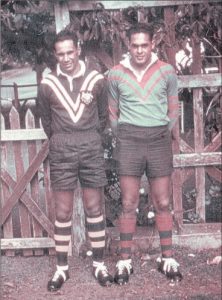
Another factor may have contributed to the dramatic downturn of fortunes experienced in 1960. For some reason Rex Fox, who had taken over the coaching duties at Wynnum in 1959 from ‘Bomber’ Brown was not reappointed for the 1960 season. His loss seemed to have a destabilizing effect on the team. Despite the arrival of Billy McDermott and the presence of Lionel Morgan, Wynnum-Manly slumped to the bottom of the table. Within a few short years only Morgan would remain from the successful 1959 team.
Wynnum-Manly were very unlucky with injuries during this time. The club recorded phenomenal injury lists during the 1960s that could account for the lack of success not only in First Grade but in the lower grades as well. Perhaps some of those injuries could have been avoided if the players were fitter.
Certainly Wynnum-Manly did not lack ambition. In 1962, signed a young John Wittenberg. Sadly he was spent most of the season on the sidelines with injury and only played about 8 games. He did though; show enough ability to represent Queensland in that year. Wittenberg would later play for Australia and in Sydney with St George. Although they had started the season well in 1962 narrowly missing a place in the President’s Cup final, Wynnum-Manly failed to figure in the semi finals.
In those days the Bulimba Cup (an annual round robin competition played between Brisbane, Ipswich and Toowoomba) generated an enormous amount of interest in the rugby league community. Billy McDermott and Lionel Morgan were two of the real stars of the Brisbane side during this time and played numerous Bulimba Cup games and matches against international touring teams.
In 1963 Wynnum signed a host of big name players including the classy five-eighth Johnny Gleeson and international rugby union convert Lloyd McDermott. A powerful Wynnum-Manly side boasting players like Gleeson, Morgan, Billy McDermott and Trevor Neibling led the competition for the first half of the season, playing in the President Cup Final (which they lost narrowly to Norths 15-14). However they faded badly due to injuries and representative commitments to miss the semi final series by 1 point. Noel Gallagher, a Wynnum-Manly junior was called up for the last game of the season and played reserve grade. Unfortunately for Wynnum-Manly, Noel moved to Bundaberg shortly after, played for Australia a few years later and toured Great Britain and France with the 1967 Kangaroos.
John Gleeson was rewarded for his performances during the year with selection as a reserve for the first Test Match against New Zealand in Sydney. In those days replacements were not allowed for international games so reserves were really shadow players who could be brought into the team at short notice if a player dropped out. At the end of the season John Gleeson was selected on the Kangaroo Tour of Britain and France making him the first Wynnum-Manly player to achieve that honour. The following year Gleeson became the club’s second international, playing in two test matches against France.
The early 1960s had seen Wynnum-Manly outlay large amounts of money to attract top players only to get minimal return for their services. Either these players got injured or spent most of their time playing representative football. At this time, there was more of an emphasis on representative football than on club games. There were a few reasons for this.
In the early 1960s a lot of top players still played in the country. In order to select the strongest possible State side it was necessary to conduct a number of trial games involving players from all over Queensland.
Also in the early 1960s the Queensland Rugby League borrowed a large amount of money from the NSWRL to build a grandstand at Lang Park (the Frank Burke Stand). In order to repay the loan, money in the form of gate receipts needed to be raised. As State Trials and games against other representative teams generated greater interest an unbelievable number of these games were played.
Typically an elite footballer playing in Brisbane at this time could expect to play in over 40 games a season. These players would often backup to play club games on a Sunday after playing a representative game on the Saturday.
Importing players into the club by offering them large amounts of money created some discontent amongst the players who had been developed through the junior ranks. Indeed Wynnum lost some top players during this time, the most notable being Trevor Neibling.
By the mid 1960s the club decided to change its payment structure and stop offering players money to sign on, instead offering substantial win bonuses. Redcliffe had employed this model successfully in 1965 when they won their first premiership.
1965 Wynnum-Manly started the season in fine style, winning their first four games and shooting to the top of the ladder. However, once again injuries hit hard (at one stage 16 front line players were unavailable through injury) and the club faded badly, missing the semi finals by several games.
By this time Wynnum-Manly were no longer playing their home games at Kitchener Park. The Ground was no longer considered suitable for conducting Premiership Fixtures. When not playing at Lang Park or the Exhibition Ground Wynnum-Manly’s ‘home’ games where scheduled at either Langlands Park (Easts ground) or Davies Park (Souths ground).
It is interesting to note that although the Brisbane Rugby League was played along District lines club games were not strictly played on a home and away basis. Instead, the BRL allocated matches to grounds, typically Lang Park, Oxenham Oval (which was, at the time Norths home ground and is now occupied by Toombul Cricket Club), Langlands Park and Davies Park. Not only that, the BRL actually collected all of the gate money and then redistributed it back to the clubs.
The desire for a permanent home ground in the district saw Wynnum-Manly purchase land at Wondall Road in 1964. The ground was completed in 1967 and Wynnum-Manly began playing home games at Wondall Road (though the BRL would still allocate their games to other grounds from time to time) as it was initially known. By 1971 the Management Committee had renamed the ground Kougari Oval. The word Kougari is from the language of the Yugumbir tribe and means, somewhat appropriately, Seagull.

During the mid 1960s, goal kicking second rower Alan Monaghan become the first player to play 100 A Grade games for the club. It was during the late 1960s that Brisbane clubs began to adopt emblems and team mascots, as the profile of the local competition was raised. Arguably Valleys had been known at least unofficially as the Diehards for some time. Thus Wynnum-Manly became known as the Seagulls.
In 1968 Wynnum-Manly started the season with a bang by winning their second Trophy, with victory in the Woolies pre-season competition. The Seagulls five-eighth Claude McDermott (brother of Bill) was voted player of the tournament. The Pre-Season competition was held over a single weekend and played in a knockout format of 25 minutes each way games. In the final Wynnum-Manly defeated Valleys by 15 points to 2.
The club featured prominently in the first half of the season before fading to miss the semi finals. Again Wynnum-Manly were plagued by injuries and lost several key players including a now veteran Billy McDermott who was forced into retirement. The lower grade sides figured better with the C Grade team making the Preliminary Final in 1968 and featuring in the Semi-Finals again in 1969.
Also in 1969, Wynnum-Manly’s colts team enjoyed the rare distinction of going through their season undefeated. Many of these colts found themselves playing grade football before the end of the season.
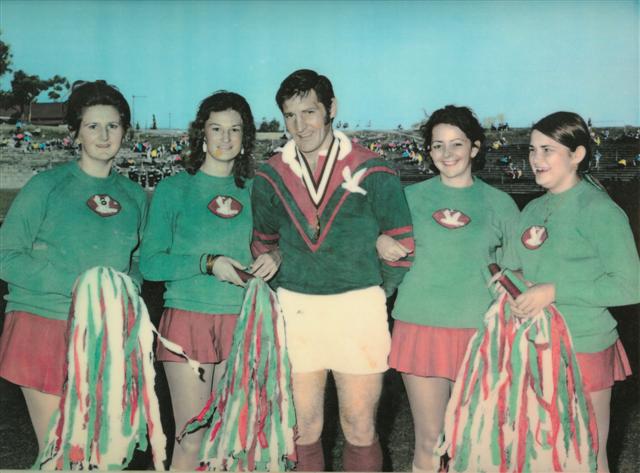
The early 70s saw Wynnum-Manly once again at the foot of the premiership table in the top grade (They finished last from 1970-1973). Despite this, the club managed to finally break through and win its first premiership in 1972 by defeating Northern Suburbs in the C Grade Grand Final by 9 points to 2. Also in 1972, Len Brunner became the club’s first Rothmans Medal winner. The Rothmans Medal was at the time, generally acknowledged as the premier award for an individual player. It was awarded to the best and fairest player of the year, as voted by the referees. Other Wynnum-Manly players to win this award include Ian French (1985), Gene Miles (1987) and Neil Tienery (1989).
Although Wynnum-Manly continued to struggle on the field, there was no lack of attempt to improve the side’s fortunes by club management. A number of high profile coaches were appointed during the 1970s including Brian Davies, Henry Holloway, Dennis Ward and Tom Berry.
The club also bought and bred an array of top players during the 1970s including John Rhodes, Neville Hornery, Lew Platz, Warren Orr, Bob Hardie, Barry McTaggart, Ron Milne, Keith Smith, Gary Seaton and John Dowling.
In 1974 Wynnum-Manly staged a remarkable comeback to just miss the semi finals. At the half way mark of the season they were coming last (again). However the Seagulls stormed home in the second half of the season to miss the semis by just 2 points.
It was during this time that the Brisbane Rugby League competition was arguably at its strongest. The Bulimba Cup had been discontinued a few years earlier and the vast majority of talented country players were being lured to the city. This coincided with a greater interest in the BRL competition. Premiership matches were now being televised and suburban grounds were regularly packed each weekend. It wasn’t uncommon for crowds of 20,000 to attend the match of the day at Lang Park.
In 1975 and 1976 the BRL introduced a 5 team Semi-Final series in the 8 team competition. Wynnum-Manly defeated Eastern Suburbs in the first knockout Semi-Final before losing to eventual runners up Redcliffe. It was the first time in 16 years that Wynnum-Manly had featured in an A-Grade semi final series. To further add to the clubs delight, the Seagulls were triumphant on Grand Final day in both C (22-13 over Wests) and Reserve Grade (23-9 over Norths). 1975 saw Wynnum-Manly double their international count with John Rhodes and Lew Platz gaining Australian selection for the World Cup that was held that year.
1976 saw Wynnum just miss the Semi-Finals. In a remarkable conclusion to the regular season Wynnum-Manly finished level on points with Souths and Brothers necessitating a 3 way play-off to determine 5th place. Souths got through, defeating both Brothers (on Tuesday) and Wynnum-Manly (on the Thursday). As a side note, Norths, who finished with the wooden spoon, were the only club not to be involved in the play-off series that year.

Although the A grade team had fallen just short, both the Reserve Grade and C Grade teams went all the way through to Grand Final Day, where the C Grade side repeated their success of the previous year by defeating Easts 20-7 while the Reserve Grade side were defeated 17-9 by Wests. It is interesting to note that Wynnum-Manly’s hooker in the C Grade Grand Final was none other than David Green who would go on to be an integral part of the highly successful Wynnum sides of the 1980s.
The late 1970s would be a disappointing time for the club’s supporters as Wynnum-Manly failed to build on the success and potential displayed in the mid 1970s. The club continued to be competitive in the lower grades; indeed they were semi-final regulars in C and Reserve Grade. In 1979 the club won its fourth C Grade title, defeating Valleys 5-0. Although the A Grade side finished last a number of players who would become familiar names to all BRL supporters has started to emerge. David Green, Ian French, Ray ‘The Tank’ Duncan, Darryl Jenner and Brian Walsh all played for Wynnum during this time.
In 1980, Eastern Suburbs incredibly sacked their highly successful captain-coach Des Morris. In 12 seasons with the Tigers, Morris had captained the victorious 1972, 1977 and 1978 premiership winning sides (he was captain-coach in 1977 and 1978). Generally regarded as one of the best Queensland players not to represent Australia, Morris felt he still had something to offer and fortunately Wynnum-Manly had the foresight to sign him. Morris took over as Captain-Coach in 1981 after the departure of Henry Holloway.
The appointment of Des Morris as Captain Coach marked the beginning of the club’s greatest era. For the next 7 years Wynnum-Manly would be the dominant force in the local competition, arguably assembling the best club side the BRL has ever seen. A number of new signings in 1981 would become synonymous with the success of the Seagulls including Colin Scott, Gene Miles, Greg Dowling, Brett French, Mark Zillman and Terry Butler.
1981 was very much a case of history repeating itself. The team emulated the feat of the great 1959 side by winning the President’s Cup (over Redcliffe who were Captain-Coached by Arthur Beetson) and making the Preliminary Final where they lost 16 points to 11 to eventual premiers, Mal Meninga inspired Souths.
The following year saw a number of changes to rugby League in Queensland. A state wide competition (the State League) was played for the first time, necessitating a rescheduling of the Brisbane Club Competition from 3 rounds to 2. Of course, 1982 was also the first time that the entire interstate series was played under the State of Origin concept.
Wynnum-Manly received a boost early in the year when Des Morris was able to convince his brother, Rod join the club. Like Des, Rod Morris had been an integral part of the highly successful Eastern Suburbs sides of the 1970s. After a successful stint in Sydney with Balmain, Rod had returned to Brisbane to retire. His experience would prove vital to the Seagulls who struggled to find consistency for much of the season. The Seagulls finished the regular season in 3rd position, finishing the year by defeating the previously unbeaten Valleys and losing to wooden spooners, Wests. In the knockout semi-final they annihilated Redcliffe 35-0. From there, they went on to defeat Valleys 26-5 in the preliminary final.

Finally, after 32 years Wynnum-Manly would play in a first grade grand final. With the entire Wynnum District swathed in Red and Green, the club completed the fairytale with a 17-3 victory over defending premiers Souths.
Souths coach, Bob McCarthy summed up the game perfectly when he said ‘our defence was great, theirs was magnificent’. In scenes previously unheard of in Brisbane sport the district went into a week of celebration. Wynnum’s stunning run in the 82 semi final series had seen them score 78 points in 3 games and concede just 8.
The club was further rewarded when Gene Miles and Rod Morris were selected in the 1982 Kangaroo Touring Team. Colin Scott could have been considered unlucky to be omitted. This side, thought of by many as the greatest to leave Australian shores became the first team to complete the tour (22 games) undefeated.
After the euphoria of 1982, the following year was a bit of a disappointment for the Gulls. The club lost a number of key forwards including Rod Morris and Gary Seaton (retired), Greg Dowling (injured) and Brian Battese (transferred to Western Suburbs in Sydney). The highlight for Wynnum-Manly was Colin Scott and Gene Miles making their Test debuts. After finished equal 4th in the regular season, Valleys eliminated Wynnum-Manly in a playoff. Brett French, Colin Scott, Greg Dowling and Gene Miles were selected for a Queensland Resident tour of England at the end of the season
1984 began with the sensational news that Wally Lewis was to join the club. After 6 years with Valleys, the man seen by many as the reason for the resurgence of rugby league in Queensland during the 80s was now a Seagull. Wally had always had an association with the club, having started playing football with Cannon Hill Stars (a Wynnum Junior club). Wally’s father Jim had coached the clubs inaugural premiership winning side (1972 C Grade). Jim Lewis also coached the First Grade team in 1976. Boasting the likes of Miles, Dowling, Lewis, Scott, Ian and Brett French and the 3 (unrelated) Green’s (Mal, David and Warren) Wynnum had assembled arguably the greatest club side even seen in the Brisbane Rugby League Competition.
Even so, it was the Wayne Bennett coached Southern Suburbs featuring the likes of Gary Belcher, Mal Meninga, Peter Jackson and Bob Lindner who set the pace in the first half of the season. Souths defeated Wynnum-Manly in the final of the Pre-Season competition. Wynnum struck back by winning their first State League Competition, defeating Souths 21-10. It is interesting to note that Wynnum-Manly’s opponents in the semi final were North Queensland. Although Wynnum won the game 22-0 the match was significant as it was the first time that a country based side had made the finals of the State League Competition and one of their players (Dale Shearer) would go on to be one of the greatest players to play for Queensland in the State of Origin era.

On the representative front, a number of Seagulls made their presence felt during the season. The Combined Brisbane side featuring Colin Scott, Gene Miles, Wally Lewis and Greg Dowling defeated Eastern Suburbs of Sydney 12-11 in the final of the National Knockout competition (the Panasonic Cup) to give them their first and only title in this competition. The Queensland State of Origin side underlined their new found dominance of NSW by convincingly winning the series. The Queensland dominated national team then went on to defeat the touring British Lions 3-0 in the Test Series. Wally Lewis, Gene Miles and Greg Dowling all played for Australia in the series with Wally Lewis as captain, the only Wynnum-Manly player to attain that honour. Interestingly enough, although Lewis was captain of Australia, Queensland and Brisbane it was David Green who captained the Seagulls that year.
By the end of the regular season Wynnum had well and truly established their dominance on the domestic front by securing their first Minor Premiership. In the major semi final they convincingly disposed of Souths to book a place in their second Grand Final. The only sour note was the sending off of fullback Colin Scott in this match. Subsequently he was suspended from the Grand Final. Souths defeated Valleys to earn another shot at Wynnum. However on the day they were devastated by a rampaging Wynnum side. The final score was 42-8, a record margin for a Brisbane Grand Final. Ironically Wynnum’s best on the day was stand-in fullback Brian Walsh, one of the most versatile players to have ever played for the club.
The Brisbane media were so confident about the strength of this super Wynnum side that they suggested a challenge match between the Seagulls and the Sydney Premiers Canterbury Bankstown.
The following year shaped up to be even better for the Seagulls. As well as retaining all of their big name players, Wynnum managed to lure Bob Lindner to the club. Des Morris, arguably the most successful Brisbane coach of the modern era was appointed coach of both Brisbane and Queensland.
However, things began to go wrong even before the season proper had begun. In a pre-season trial in Northern NSW champion centre Gene Miles suffered a severe knee injury. Although ‘Geno’ got back on the field at the end of the season he would not be back to his devastating best until 1986.
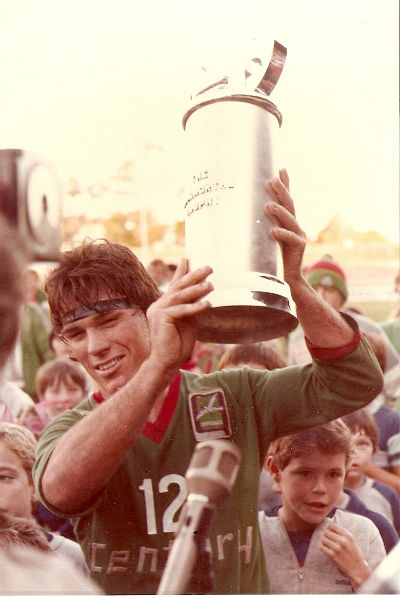 Wynnum-Manly started the season well by winning both the Pre-Season and State League titles (16-0 verus Brothers). The Seagulls again dominated the representative sides, however after the previous year’s results both were disappointing. A Wynnum-Manly dominated Brisbane side were defeated by ultimate Cup Winners Balmain in the first round of the competition. NSW, inspired by Steve Mortimer, went on to capture their first State of Origin series win.
Wynnum-Manly started the season well by winning both the Pre-Season and State League titles (16-0 verus Brothers). The Seagulls again dominated the representative sides, however after the previous year’s results both were disappointing. A Wynnum-Manly dominated Brisbane side were defeated by ultimate Cup Winners Balmain in the first round of the competition. NSW, inspired by Steve Mortimer, went on to capture their first State of Origin series win.
As the season wore on key players such as Bob Lindner (broke a leg in a State of Origin game), Mal Green and Brian Walsh suffered season ending injuries. A sign of changing fortunes was the defeat of an admittedly under strength Wynnum-Manly team by emerging Brisbane power club, Brothers, in the final of the Presidents Cup. However it would be another issue that would shake the club to its very foundations, money or rather specifically the lack of it. The Seagulls had over the last few years acquired a champion team and suddenly found they could not pick up the bill. After being told throughout the year that owed monies would be forthcoming, late in the season the players were finally informed that the club was almost bankrupt, no one would be paid.
With heavy hearts, the players battled through to a second consecutive Grand Final. Once again they faced a strong Souths team. After the previous years humiliation Souths had spent the entire year preparing for Wynnum. Everything they did that year was in preparation for this game. In the end it paid off as they were worthy winners defeated Wynnum-Manly in a close game 10-8.
Ian French capped off an outstanding season by deservedly winning the Rothmans Medal for the best and fairest player of the year.
At the end of the season, after a vote of no confidence the entire board resigned. David Green retired from playing and become President of the football club. An unfortunately victim in the cleanout was the coach Des Morris. He wasn’t appointed for the following season. Ultimately Wally Lewis took up the dual role of captain coach for the next season.
Several top players including Brett French, Terry Butler and Gary Coyne left at the end of the 1985 season. With the new player oriented administration attempting to solve the clubs woes off the field, Wynnum-Manly began the new season well by winning the Pre-Season competition. Both Gene Miles and Bob Lindner made successful comebacks from the serious injuries they suffered the previous season. Wynnum-Manly enjoyed further success by winning the State League Final, annihilating Redcliffe 46-10. Much of the prize money being used to pay out moneys that were owed to various players.
It was during this season that murmurings of a Brisbane based team playing in the Sydney Competition began. In the end it didn’t eventuate but the writing was clearly on the wall for the Brisbane Clubs. It would only be a matter of time before it became a reality.
Once again Wynnum-Manly provided a bulk of the players for the Brisbane and Queensland representative teams. Despite their financial predicaments, the club managed to recruit English centre Tony Marchant who arrived for a brief stint. Relying on a combination of the big guns (Wally Lewis, Miles, Scott, Dowling, Lindner and Ian French) and the largely unsung heroes (Scott Lewis, Peter Dawes and Craig Farrugia).

performance seen from any team in a Grand Final
Wynnum-Manly sowed up their third trophy of the season by again winning the Presidents Cup. To complete a perfect season they only needed to secure the Premiership. This they duly did, overcoming a tenacious Brothers side 14-6.
The strength of this Wynnum-Manly side was reflected when four of the players were selected for the end of season Kangaroo Tour of Britain and France. Wally Lewis, Gene Miles, Greg Dowling and Bob Linder each played in all of the Test Matches. Tony Marchant, the Englishman who had played a handful of games for Wynnum-Manly in 1986 played in one of the Test Matches for Great Britain. The 86 Kangaroos emulated their predecessors by completing the tour without dropping a game.
1987 began with the new that a Brisbane team would indeed be playing full time in the Sydney Competition at the start of the new season. Wynnum-Manly’s precarious financial position forced them to let several more top players leave. Amongst those who moved on were Ian French (who joined his brother Brett at North Sydney), Greg Dowling (Brisbane Norths) and Craig Farrugia (Gold Coast).
Wynnum-Manly, heavily reliant on the ‘big three’, Wally Lewis, Gene Miles and Colin Scott could not maintain their consistency. The highlights of the season were the capture of the clubs 4th (consecutive) State League title (36-14 over Redcliffe) and Gene Miles being voted the Best and Fairest player for the season. Some of the younger players to make a name for themselves during the season included John Plath and Andrew Tessman. Wynnum-Manly finished fourth in the regular season and were eliminated in the Knockout semi-final by Redcliffe. It was the end of an era. Between 1981 and 1987 Wynnum-Manly had won 3 Premierships, 4 State League Titles, 3 President’s Cups and 2 Preseason Trophies.
The arrival of the Brisbane Broncos had an immediate and devastating effect on the local competition. The better players that were not snapped up by the Broncos found opportunities at other Sydney clubs or in England. Although in fairness the Brisbane competition had been in decline for some years, it was relegated to a second rate League almost overnight. Although some top class players remained in the competition the media focus was very much on the new Brisbane team.
Without the high profile players of the previous years the Seagulls quickly slipped to the bottom of the table. At this time Wynnum-Manly’s focus was purely on survival. The situation was so serious that they, along with a few other Brisbane clubs were only a year to year proposition. With the club in receivership, creditors were looking at ways to wind the club up.
That Wynnum-Manly ultimately managed to survive was a credit to its army of supporters and tireless unpaid officials who had followed the club in both the good times and bad. The team moved away from Kougari for a year (games were played at Kirawana Park) as various fund raising proposals were considered. In the end the club returned to Kougari, no longer as Wynnum-Manly but to be known as the Wynnum Seagulls.

The appointment of former Wynnum star and member of the inaugural premiership winning side, Gary Seaton coincided with the beginning of a new era of prosperity for the club off the field. The legalisation of poker machines in Queensland would allow the Wynnum Leagues club, with its large patronage to grow enormously in the next decade. This was illustrated quite literally by the redevelopment of the Leagues Club, which would eventually see it run three quarters of the length of the playing field.
For the first time in the post Bronco era, Wynnum made the semi finals in both A and Reserve Grade. This Wynnum team, unlike their highly successful predecessors, was predominantly made up of local juniors. For long time supporters, a touch of nostalgia was added by the presence of second generation Seagulls such as Craig Greenhill (nephew of Lew and Bob), Jeff Wittenburg (son of John) and the now veteran Brad Morgan (son of Lionel).
Greenhill and Wittenburg both left Wynnum at the end of the season to pursue their football careers in Sydney. In 1993 the Reserve Graders claimed the clubs Second Title in that grade. Although Wynnum were competitive around this time, consistency eluded them and they failed to make the semi finals in 93 and 94.
In 1995 Wynnum signed former Ipswich and Western Suburbs (Sydney) forward Pat O’Doherty. They also secured the services of a couple of Balmain players, Geoff Hassan and David Chapman. After a slow start to the season (only 3 wins out of the first 11 games), the Gulls under new coach Peter Donkin surged into the Premiership Frame by only losing one game in the second round and finishing the regular season in 3rd place.
After suffering a heavy defeat from Easts in the major semi-final, Wynnum bounced back, inspired by skipper Ricky Taylor to defeat Brothers in the preliminary final and qualify for their first Grand Final appearance in a decade. The Preliminary Final was played as a curtain raiser to an ARL Semi Final and gave the players of both clubs a rare opportunity to perform in front of a capacity crowd.
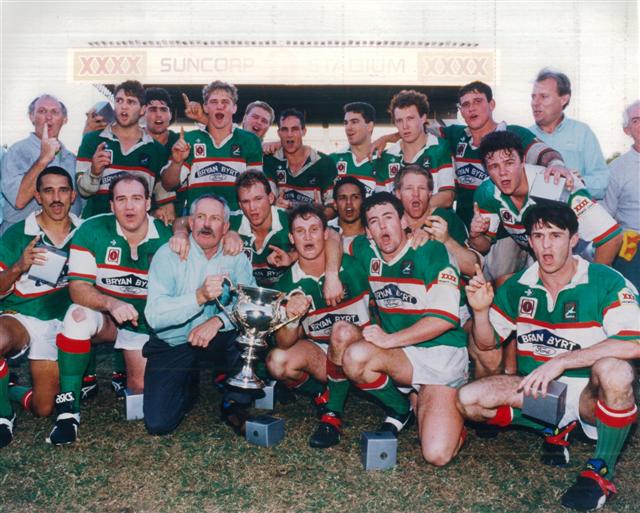
The Grand Final was an absorbing game, which seesawed throughout. In the end, Wynnum deservedly won 32-24 to claim their fourth A Grade title. To cap off a memorable day for the club, the Under 21 side was also victorious, defeating Souths 12-10.
1996 saw domestic rugby league revamped in Queensland with the introduction of a State League style premiership competition. The birth of the Queensland Cup would see Brisbane based sides pitted against teams from places such as Toowoomba, Mackay and the Gold Coast. Even Port Morsby fielded in team in the first few years of the Queensland Cup. Although Wynnum still had a strong side, a couple of tight loses cost them a place in the semi-finals.
The following year saw the club put in a great performance during the regular season and rightly top the ladder and claim the clubs second minor premiership. Unfortunately they crashed out of contention by losing three consecutive semi finals.
1998 marked the end of what had been a good showing during the 1990s. In the Premier League, Wynnum just scrapped into the semi-finals, but were eliminated in the first knockout game. The club faired better in the lower grade, taking out the Reserve Grade title.
For the next couple of years the Wynnum Seagulls were disappointing. Even the presence of John Plath, who returned to Wynnum to finish his playing career after a long and successful stint at the Brisbane Broncos failed to lift the fortunes of the team. In 2001 Wynnum just missed out on making the semi finals after a slow start to the season. The following year saw the arrival of coach Kelly Eagan and once again, after a slow start, Wynnum rallied in the second half of the season only to just miss a play-off spot.
However progress was being made. In 2003 the Wynnum Seagulls enjoyed on of the most successful years in the clubs history. For only the second time they appeared in the semi finals in all three grades (Premier League, A Grade and Colts). The Premier League side made the Preliminary Final, before succumbing to Redcliffe, while the A Grade side were defeated by Redcliffe in the Grand Final.
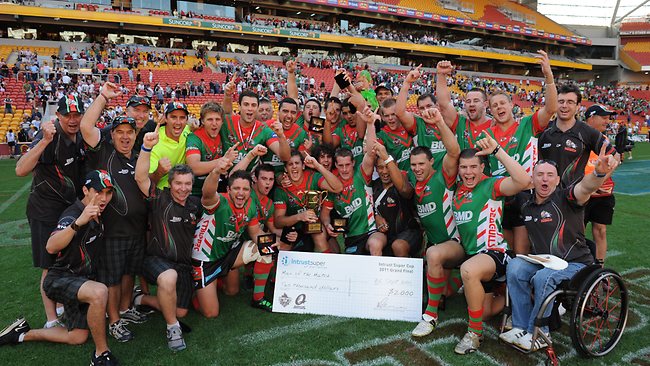
The Wynnum Manly Seagulls have completed the fairytale they longed for and have taken out this year’s Intrust Super Cup grand final. The Seagulls, who were the first team to make the grand final in the history of the Queensland Cup competition from sixth position. For the Tweed Heads Seagulls, it was a heart-breaking result after they dominated the competition for most of the year – losing only the one game in the regular season. However, the team that stunned them in the semi-final – the Wynnum Manly Seagulls – were able to do it all again to claim their first premiership win since their 1995 Brisbane Rugby League triumph. Final score 16-10.
